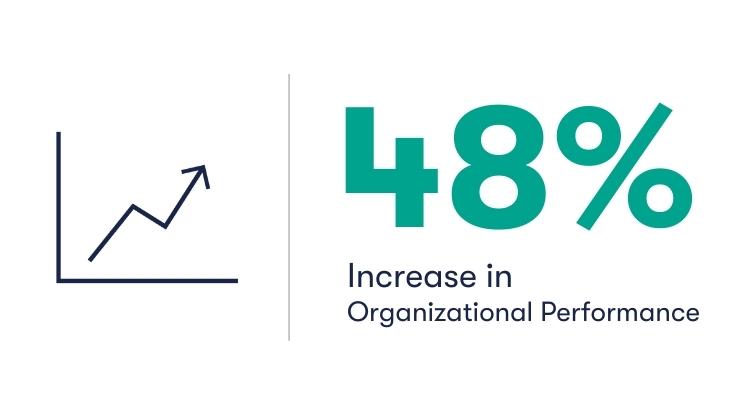You are here: American University Provost Office of Graduate & Professional Studies Executive Education Executive Coaching The ROI of Executive Coaching
Contact Us
The ROI of Executive Coaching

Executive Coaching is a proven way to develop individual, team, and organizational performance across industries. A Metrix Global study found that executive coaching has a 788% return on investment (ROI) based on factors including increases in productivity and employee retention.
What kind of results can you expect through providing coaching at work? The International Coaching Federation (ICF) reports the following statistics on the benefits of executive coaching:

- Goal attainment
- Clearer communication
- Higher satisfaction

- Better conversations
- Improved collaboration
- Enhanced work performance

- Increase in revenue
- Increase in employee retention
- Customers as advocates
Explore how coaching can be the framework for successful change and growth at your organization.
 Coaching = Successful Behavioral Change
Coaching = Successful Behavioral Change
 Steps to Building a Coaching Culture
Steps to Building a Coaching Culture
What is a Coaching Culture?
Recent research conducted by Gallup shows that today’s employees want a coach, not a boss. That means transitioning managers from the role of delegation to developing productive and satisfied employees through goal setting, having meaningful and empowering conversations that lead to the achievement of the desired goals. A coaching culture is based on the principles of mutual respect and positivity. At its core, coaching is about an action that inspires change.
Change is hard. Whether you’re trying to develop a new skill, improve work relationships through better communication, or break a bad habit that is hindering your success. However, change at some point is necessary—it is a critical step toward fulfilling individual potential and the achievement of goals. For that, employees need a supportive framework. That framework is coaching.
Coaching = Successful Behavioral Change

When you set a goal to change something about yourself, like meeting deadlines at work, it requires a change in your behavior. That is how you gauge your success at meeting the goal. However, behavioral change is the most challenging step in obtaining that goal. For example, I know I want to meet my deadlines but what are the steps to get me there? Left to your own devices, you are 80% likely to fail. Why? Our brains are built that way.
Behavioral change that requires both new high-level skills and high motivation to implement those skills is in fact the hardest behavioral change to achieve (The Neuroscience of Goals and Behavioral Change, March 2018).
Two strategies improve the success of behavioral change:
- acknowledging and rewarding small steps in achieving the goal
- linking the goal to a person’s core values and sense of self
Executive coaches help you do just that! Coaches develop the scaffolding needed to achieve successful behavioral change. During scheduled one-on-one meetings, coaches encourage self-awareness, they break down their client’s goals and desired behavioral outcomes into bite-sized steps in order to identify and provide input for a shift in strategy to meet their goals. The shift in the client’s strategy is ultimately based on their core values and sense of self.
As a result, organizations that offer training alone experience 22% increase in productivity, but when combined with coaching that figure rises to 88% (Gerald Olivero, Denise Bane & Richard Kopelman, Public Personnel Management).
Real-Life Coaching Example
 Take a look at what successful behavioral change looks like in the real-life coaching example below.
Take a look at what successful behavioral change looks like in the real-life coaching example below.
Scenario: A client has difficulty building an inclusive and results-oriented environment during team meetings.
- Coach: What would it mean to actively listen to your direct reports at a team meeting?
Coach asks a powerful question that deepens the client’s self-awareness.
Result: The client reflects on the question. As her awareness grows, she begins to experiment with different strategies. - Client: I tried to listen, but I can’t help offering strong opinions.
Result: With self-reflection and the coach’s feedback, the client begins to process what worked/didn’t work and the reason behind it. The client admits that she felt a loss of control because she’s used to driving meetings and strategy.
- Client: I tried again, and this time asked what each person thought before weighing in with my opinion.
Result: A successful meeting is the result of my team’s perspectives as well as mine. - Client: Repeat the successful strategy.
Result: Behavioral change based on a change in core value: What does success look like?
Steps to Building a Coaching Culture

-
Define how you can better meet your strategic goals through executive coaching.
Align your organization’s strategic goals and how executive coaching can serve as the vehicle to achieve those goals (Training Mag). In addressing the cost of executive coaching, be sure to feature the significant 788% ROI.
They can expect improvements in individual, team, and organizational performance.-
70% increase in Individual Performance (goal attainment, clearer communication)
-
50% increase in Team Performance (Improved collaboration)
-
48% increase in Organizational Performance (increase in revenue and employee retention).
-
-
Get buy-in from senior leadership.
By showing how executive coaching will help achieve the organization's strategic goals, you should get your buy-in from senior leadership. Once on-board, senior leadership should define building a coaching culture as a priority. Coaching as a strategy to improve performance should be included in agendas, discussions, and meetings. Senior leadership should set an example by acquiring training to start the practice of coaching with their own direct reports.
-
Establish how you will define success.
Set clear expectations for the outcomes of the coaching initiative. Define your expectations and set goals for the coaching implementation both quantitatively and qualitatively. For example, what kind of survey results and hard numbers will indicate improvement or success. Communicate goals across all levels of the organization.
-
Provide ICF-accredited coach training to your managers and leaders.
Using internal or external coaches to train your leaders will teach them how to successfully implement the coaching framework employees need to achieve their goals. The effects of individual achievement will cascade into your teams and ultimately increase organizational performance including revenue.
-
Measure coaching impact.
Did you meet individual, team, and organizational goals?
What was the return on investment and return on expectations?
To gauge implementation success, conduct a qualitative and quantitative analysis of coaching in your organization.- Qualitative Analysis: Use employee and supervisor surveys to gauge the level of goal attainment and behavioral change.
- Quantitative Analysis: Review data on productivity, retention, and revenue before and after coaching implementation.
-
Communicate success.
Share results across all levels of the organization on a quarterly basis.

